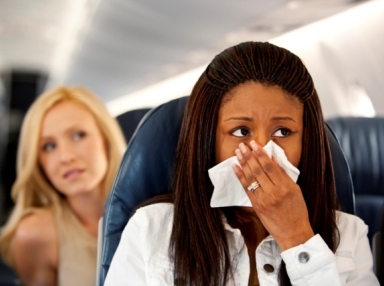When the flu hits, manners may not be the first thing that comes to mind. Yet, good “flu etiquette” and hygiene can go a long way in helping to prevent the spread of influenza. While most Americans recognize that the flu virus spreads easily, they admit to sometimes forgetting their manners when they have the flu: a 2011 survey of more than 1,000 Americans found that three out of four Americans (75%) would go to at least one social situation if they had symptoms of the flu (out of a list of seven).
Influenza, or “the flu,” is a contagious viral infection of the nose, throat, and lungs which occurs most often in the late fall, winter, and early spring. Flu is a serious infection which is associated, on average, with more than 200,000 hospitalizations due to flu related complications and can lead to thousands of deaths every year in the United States.
“No one wants to spread the flu to family, friends, or colleagues. Yet many of us admit to tossing our manners aside when we have the flu,” said Anna Post, great-great-granddaughter of Emily Post and co-author of the 18th edition of Emily Post’s Etiquette. “Knowing how to politely cancel an event you’re hosting or how to avoid shaking your client’s hand because you’re sick can help avoid a potentially difficult and awkward situation. By following appropriate flu etiquette, we can all play a role in preventing the spread of the flu virus.”
The Emily Post Institute offers the following etiquette tips to manage common situations where the flu virus might be spread from one person to another:
1. Share space, not the flu – Covering sneezes and coughs is a good habit all year round, especially during flu season. The flu virus can spread up to six feet away from coughing, sneezing, or even just talking.
2. Know when to take a sick day – The flu is highly contagious and the people you work with don’t want to get sick. Knowing the symptoms of flu versus a cold is important so you know when to take a sick day and see a doctor. Remember the acronym F.A.C.T.S. to recognize if you might have the flu (Fever, Aches, Chills, Tiredness with Sudden Onset).
3. In tight quarters – It’s tough to point out someone’s behavior mid-flight with hours left to go. However, flu is highly contagious. If there’s no other seat available, consider saying, “I can see you’re not feeling well — would you mind covering your mouth when you cough? Thanks.” Most people when prompted are eager to show good manners and do the right thing.
“Every year, millions of Americans get influenza. We are all personally responsible for helping to control its spread,” says Susan J. Rehm, MD, medical director at the National Foundation for Infectious Diseases (NFID). “The Centers for Disease Control and Prevention recommends flu vaccine as the first and most important step in preventing influenza, as well as good hygiene. If symptoms arise, see a doctor quickly. The flu can be treated with prescription antiviral medicines.”
To help children recognize flu symptoms, learn good habits, and pass the time with a fun activity this winter, download a free coloring book at FluFACTS.com. On FluFACTS.com, you’ll find information to help you distinguish between flu and cold symptoms, sign up for flu alerts in your area, and download a free “Fight the Flu” iPhone app.
This influenza education campaign and survey are supported by Genentech, a member of the Roche Group.



































